To celebrate the release of Star Trek: Into Darkness this month, we’ll be running through the first season of the classic Star Trek all this month. Check back daily to get ready to boldly go. It’s only logical.
It is really hard to believe that this is the first time we’ve really had one of these plots, with the Enterprise visiting an alien civilisation, meddling thoroughly and freeing the population from oppression. Of course, that’s probably because the universe seemed so vast an empty in the first few episodes. The only planets seemed to be either lifeless rocks or human colonies. From this point on, the galaxy is going to seem a whole lot busier.
Return of the Archons is a little bit like an expansion of the archetypal Star Trek plot established in What Are Little Girls Made Of? The Enterprise visits an alien world following up on the disappearance of Federation personnel. When they arrive, they discover sinister plans afoot involving evil artificial intelligences that plan on stomping out free will. Kirk promptly uses his humanity to talk the machines into destroying himself.
However, Return of the Archons deals with a whole civilisation trapped in the midst of this sinister robotic plot. Kirk and his crew aren’t strolling through an alien graveyard. This is a living, breathing society. And this is the first time that Kirk would save an entire civilisation.
There is – to be fair – also a more fundamental similarity between Return of the Archons and What Are Let Girls Made Of? Both seem particularly haunting and unnerving, unsettling and uncanny – depicting a cold and horrific universe housing bizarre terrors that are hard to completely comprehend. The Enterprise arrives at “red hour”, a time of violence and debauchery. They watch a whole peaceful town nearly tear itself apart at 6pm in the evening, as the residents indulge in “the festival”, an almost pagan rite where they seem to satisfy their basest desires.
It’s a really weird image, and it’s unnerving precisely because it is so strange. Much like the taunting chants of the children in Miri, we’re presented with something that should be absurd, but is handled in such a straight-forward manner that it makes us uncomfortable. It’s the kind of all-out approach that the original Star Trek did so well, taking an idea which sounds absurd on paper and playing with it anyway.
The fact that the culture looks like nineteenth-century Earth probably helps as well. There’s probably a practical reason for that, as it’s cheaper to use sets and costumes that would already exist for other projects. The costumes and sets look like they have wandered out of a western, one of the more popular genres of the sixties. It actually doesn’t seem that surreal, given that Star Trek has so consciously been channelling the western genre since it started being broadcast.
It helps that, unlike Miri, we don’t get an remarks passed about why this planet’s culture resembles our own or even why these aliens look human. They just are. Maybe this phase of evolution is just logical for humanoids on a planet like this, using the raw materials available. Maybe this is a long-lost colony of space!Luddites. The episode doesn’t try to account for it, and it works better that way, forcing the viewer to try to come up with their own internal logic to justify a fairly understandable production choice.
Still, presenting this as a community that resembles a western settlement works a lot better than designing a sixties futuristic society would. Watching people wearing silly costumes in bright colours acting crazy is nowhere near as effective as the image of an old town suddenly going completely off the rails because the clock struck 6pm in the evening. Seeing the familiar acting unfamiliar is so much more unsettling than seeing things that are strange doing strange things.
The logical questions that arise from this just add to the confusion and make it all even harder to make sense of. Isn’t it a bit of a coincidence that this planet also has a day that can be divided into blocks of twelve hours? What is life like outside this one town? Is there an entire world populated with cities like this? Is there any power block on the planet which doesn’t worship Landru, and does everybody worship Landru in the same way?
There’s an underlying horror here, one which resonates with the sense of Lovecraftian horror that tends to permeate the original Star Trek, despite being mostly absent from the spin-offs. This is something which we perceive to be familiar, but beneath this civilised society is insanity. There’s also the sense that the universe is incredibly vast and full of horror. The Archon disappeared a century ago, and the Enterprise is only getting around to looking for it now. That’s a terrifying thought. If anybody survived, they would have died of old age, alone, surrounded by insanity and far from home, long before help arrived. That’s a chilling notion.
Part of what makes Return of the Archons so fascinating is that it is so wilfully difficult to figure out. What is Return of the Archons actually about? Is it a warning about religion? Gene Roddenberry was an avowed atheist, and there’s certainly enough evidence here to support such a reading. We’re repeatedly told that people are or are not “of the Body.” This calls to mind the description of the Church as the Body of Christ in Corinthians 12:12-14:
For as the body is one, and hath many members, and all the members of that one body, being many, are one body: so also is Christ.
For by one Spirit are we all baptized into one body, whether we be Jews or Gentiles, whether we be bond or free; and have been all made to drink into one Spirit.
For the body is not one member, but many.
Landru is treated is a religious figure. Reference is made to “the will of Landru” and to “the Word.” It seems the belief system treats him as a religious figure. The calendar seems to mark time from Landru’s arrival – we’re told that advanced technology exists as a relic from “a time before Landru.” Landru is treated as all-knowing and aware of everything. “Do you say that Landru is not everywhere?” Hacom asks, as if preparing a charge of heresy.
The inhabitants of the planet have incorporated the arrival of the Archon into their mythology. It seems appropriate. “Archon” evolved from a Greek word translated as “ruler”, and is itself an important part of Judeo-Christian theology. The early Jewish text, the Book of Enoch, refers to twenty archons ruling the thousands of angels serving in heaven.
Interestingly, and apropos of nothing except the fact that it resonates quite well with this episode, the term “archon” is also used today as part of a conspiracy theory derived from gnosticism, alleging that the archons mentioned in those religious texts were actually aliens. They are a massive part of David Icke’s conspiracy mythology. As with The Naked Time, it’s interesting how the original Star Trek seemed to play with millennial social anxieties.
In this case, it was entirely accidental. As George Takei explains on the introduction to the VHS edition of the episode:
The name Archon came from Gene’s past. It was a name of a service club to which he had belonged during the late thirties/early forties while attending Los Angeles City College.
Still, it’s interesting that Return of the Archons should pitch the Archons as visitors from the sky before conspiracy theorists would latch unto a similar idea.
It’s easy to read religious subtext into the plot. The robes worn by the “lawgivers” seem designed to evoke the dress of monks. The fact that the lawgivers strike with empty hallow tubes that seem to be powered from elsewhere conjures up the image of an angry deity smiting his followers. That which disagrees with religious teaching is different and dangerous. Those who dare reject religious teaching are heretics and should be punished and destroyed.
The sixties was an interesting time, from a religious point of view. The notion of religious “cults” were only beginning to push their way to the front of the collective consciousness, as disenfranchised youngsters began the break away from their parents and from established society. It seemed that, in the mid-to-late sixties, the public at large began to notice the expansion of these religious organisations.
L. Ron Hubbard established Scientology in 1953, but left America to live in England in 1958. He returned to the country in the mid-1960s. In 1967, the IRS removed the religion’s tax exemption, which led to the longest lawsuit in IRS history, eventually settled in favour of the Church of Scientology. Charles Manson would establish his family at two large ranches in Death Valley in 1968. The Manson Family would expand to include dozens of people, with Beach Boy Dennis Wilson even briefly falling under his spell.
In Cults and Cosmic Consciousness: Religious Vision in the American 1960s, Camille Paglia argues that the cult was an essential part of sixties counter-culture:
What we think of as the 1960s was really concentrated into the half-dozen years after the assassination of John F. Kennedy in 1963. Cultural changes exploded and burnt themselves out with tremendous speed. The religious impulse of the sixties has been obscured by a series of scandals that began mid-decade and spilled into the seventies — communes that failed, charismatic leaders who turned psychotic, cults that ended in crime and murder. The sensational chain of events began with the dismissal in 1963 of Timothy Leary and his colleague Richard Alpert from psychology lectureships at Harvard for experimenting with LSD on student volunteers. This episode first brought LSD to public attention. An Irish Catholic turned self-described prophet, Leary envisioned a world network of “psychedelic churches” whose Vatican would be his League for Spiritual Discovery (acronym: LSD), headquartered in Millbrook, New York, until it was closed after a 1966 police raid led by Dutchess County assistant prosecutor G. Gordon Liddy. Though registered as a religious institution, the League was noted for its sex parties – reportedly a frequent attraction of Leary’s Harvard offices as well.
Those LSD-consuming cults conjure images quite similar to “red hour”, wanton indulgence of human vices as part of spiritual liberation The Christian imagery would seem to fit quite well, given the historical context. According to Paglia, “the true cults that proliferated in the American sixties and early seventies resemble those of the Hellenistic and imperial Roman eras.” As such, they would be inexorably linked with the emergence of Christianity, and so the imagery used feels strangely appropriate.
Indeed, the sudden transformations of both Sulu and McCoy when they fall under the influence of Landru evokes a cult-like mentality. They are blissfully happy, and openly hostile towards their former colleagues and friends. Despite years of Starfleet training, McCoy turns on Kirk and Spock for their perceived heresy, ranting and raving with the passion of a zealot. That sort of devotion is terrifying, especially from somebody who had been a close friend, and the whole experience seems to mirror induction into a cult.
Of course, it isn’t as simple as that. Despite the obvious religious imagery, it also seems like Return of the Archons was also written as a rejection of communism. Although Roddenberry’s Star Trek was relatively cynical about the Cold War, as we’ll see in A Taste of Armageddon and A Private Little War, the show did pick a side in the conflict. The whole situation might be terrible, but Star Trek wholeheartedly championed the Western democratic viewpoint.
As Diana J. Schaub notes in Captain Kirk and the Art of Rule, Star Trek engaged with communism on a theoretical level, ignoring arguments about whether the idea was viable. Instead, it criticised the very idea of communism as a political ideology:
Star Trek’s critique of communism is particularly important since so many people think communism is a worthy ideal that just doesn’t work in practice. Star Trek criticises the ideal itself. There are episodes like This Side of Paradise and The Way to Eden that deal with the counterculture’s version of communism – a sensual paradise of free love. There are other versions of communism more austere and religious in character like those depicted in The Return of the Archons and The Apple Whereas the first sort of communism aims at the open sharing of private bodily pleasures, the second sort suppresses private pleasure and seeks to create a larger, artificial body. The indulgent version, that might be compared to Aristophanic communism, kills human greatness; the austere version, that might be compared to the communism of the Republic, kills human love. Moreover, both versions of communism (the dispirited and the anerotic) are hostile to the exercise of human reason. Vacant stares characterise the residents of these regimes.
It’s certainly quite reasonable to read Return of the Archons as a criticism of communist philosophy. There’s a very clear conflict here between the needs of the group and the rights of the individual. “You will be absorbed,” Landru advises the rebels. “Your individuality will merge into the unity of the good, and in your submergence into the common being of the Body, you will find contentment and fulfillment. You will experience the absolute good.”
It seems like Landru is perfectly willing to sacrifice the individual for the greater social good. In order to insure the stability of the political system he has created, Landru is ready to kill not only the outsiders, but many of his own people. “Obliteration is necessary,” he explains. “The infection is strong. For the good of the Body, you must die. It is a great sorrow.” He adds, “All who saw you, all who know of your presence here must be excised.” Everything is justified by the survival of “the Body.”
As much as Landru might be presented as a religious figure, you could also argue that he fits the mold of a despot quite well. When Kirk inquires about Landru, he is informed, “He’s still alive. He is here now. He sees. He hears.” Much like it seems the authorities in despotic countries create a climate of fear, a worry that the population is constantly being watched, Landru instils a similar sense of dread in his own followers. His secret police see and hear everything, and those who disobey are taken for re-education.
Kirk’s opposition to Landru, and his intervention on Beta III is justified because he is instilling the population with Western values. “You said you wanted freedom,” he tells Reger and Marplon. “It’s time you learned that freedom is never a gift. It has to be earned.” Much like the attempts by the Western forces to free regimes held in the sway of communism, and to politically influence those on the cusp of it, Kirk’s unilateral decision to destroy the social order of Beta III is justified because he fights for democratic ideals.
When Kirk challenges Landru, he makes a case for the rights of the individual. “What have you done to do justice to the full potential of every individual of the Body?” he demands, when Landru argues that the Body is being protected. Kirk argues that it’s impossible to imagine a society without considering the individuals who inhabit that society. “Without freedom of choice, there is no creativity. Without creativity, there is no life. The Body dies. The fault is yours.”
This is a recurring theme in classic Star Trek, and it’s really an expansion of the ideas suggested in What Are Little Girls Made Of?, where Kirk rejects the notion that androids and computers might remove pain and suffering from the human equation at the cost of free will. As Jan Lundeen and Jon Wagner note in Deep Space and Sacred Time: Star Trek in the American Mythos, this is something that Star Trek would return to, time and time again:
The dominant theme in TOS’s stories of Paradise is that the cost of such a life is prohibitively high and that once in Paradise we will become trapped there, imprisoned in our own creation and denied the highest rewards of human existence. Paradise is a form of cowardice, by which we give up our freedom of thought and choice, our individuality and or capacity for passion – all in exchange for safety, security and ease. However visionary it may be in its beginnings, Paradise degenerates into a life unexamined and therefore not worth living.
So it’s no surprise that Kirk and the Enterprise arrive to destroy paradise in a society where free will has been sacrificed for convenience.
Of course, Return of the Archons does cheat a little bit by weighting the options, as Ina Rae Harker notes in BFI TV Classics: Star Trek:
This is indeed the assertion the episodes make, but it is always a loaded one. What if the inhabitants of Beta III had chosen to live peacefully and to trade progress and ambition for peace and contentment, without coercion? Contemporary fears of communist collectivism or blissed-out youth drug cultures underlie the stacking of the decks (although Spock always points out the benefits of happy stagnation). The overriding fear, as it is in all the cautionary tales of letting head prevail over heart (or Philia over Eros, as Wagner and Lundeen put it), is of emasculation.
It’s quite telling that this philosophy is where we see the biggest shift in the franchise’s philosophy, between Star Trek and Star Trek: The Next Generation. It’s interesting to imagine how differently these two episodes (Return of the Archons and A Taste of Armageddon) might have played out with Picard in command, rather than Kirk. A product of a very different political climate, The Next Generation espoused pacifism, moral relativity and non-interference.
While the original Star Trek acknowledges these values, it was not afraid to compromise. Return of the Archons famously includes the first reference to “the Prime Directive”, the cornerstone of Star Trek‘s moral philosophy – the idea that advanced civilisations have no right to impose themselves upon less developed societies. However, it is only mentioned here so that Kirk can dismiss it out of hand.
“Landru must die,” Kirk observes. Spock points out, “Captain, our Prime Directive of non-interference –“ Kirk, being Kirk is quick to find a loophole to exploit. “That refers to a living, growing culture. Do you think this one is?” It’s a fair point, but the society of Beta III have found themselves in this situation by virtue of their own choices. You could mount a convincing argument that it takes a massive amount of hubris to assume that you have the right to impose your own view – even one championing democracy – over that.
The Next Generation would adopt a much firmer approach towards moral relativism, recognising that the crew didn’t have the right to change a culture with which they did not agree. When Picard encounters a god-like being hovering over the Edo in Justice, he refuses to directly intervene. He agonised for an entire episode about how to handle (or whether to handle) the subjugation of an entire species in Symbiosis.
Of course, you could argue that Star Trek‘s approach to communism (or at least socialism) would soften over time. The thawing of the Cold War undoubtedly helped. By the time The Next Generation launched, the Federation was effectively a socialist utopia. Scarcity, a plot point in quite a few early Star Trek episodes, had been eliminated. The Federation, to quote Nog, abandoned “currency-based economics in favor of some philosophy of self-enhancement.”
Capitalists like the Ferengi in The Last Outpost and the 21st century businessman in The Neutral Zone exist so that there’s somebody for the crew to patronise. If you want to get very cynical, you could argue that the Federation in the era of The Next Generation even takes on some of the attributes of Landru on Beta III, at least if you believe Michael Eddington’s criticism of their politics and policies in For the Cause. It’s just more subtle about the way that it tries to absorb and influence the cultures existing around it.
Then again, the Federation would never employ methods similar to those used by Landru to impose his will. In a way, this sort of fear of the all-absorbing collective (particularly through the power of machines) would re-appear in The Next Generation, reimagined as the Borg Collective. It’s hard not hear echoes of their iconic mantra as Landru threatens Kirk and his fellow rebels. “Your statement is irrelevant. You will be obliterated.”
Still, it’s quite strange, after Arena went to great pains to criticise the Federation as an imperialist society, that Kirk is so comfortable about imposing human values on another civilisation. He even explicitly mentions it in his handy “closing log summation.” He notes, “Sociologist Lindstrom is remaining behind with a party of experts who will help restore the planet’s culture to a human form.” Surely he should be returning the society to “Betan norm”? (I’m not sure “Betan” is a word, but you get the idea.)
One does wonder what would have happened had the inhabitants of Beta III made a conscious choice to remain in service of Landru. Lindstrom’s closing report – “already this morning, we’ve had half a dozen domestic quarrels and two genuine knock-down drag-outs – it may not be paradise, but it’s certainly human” – suggests that the planet has some rough times ahead. If the planet decided, democratically, that it was better under Landru’s control, what right would Kirk have to intervene?
Writer David Gerrold, one of the stronger writers on the Star Trek staff, would later acknowledge that this was a bit of a failure on the part of the show. Writing in The World of Star Trek, he acknowledged that the series was an artefact of the Vietnam era:
In 1966, when Star Trek first came on the air, Lyndon Baines Johnson was President; it was a time when the Viet Nam “adventure” was at the core of the American dilemma — were we supposed to be the world’s policeman or not? As far as Star Trek was concerned, we were – because Star Trek was the galaxy’s policeman. By implication, that ratified and justified the American presence in everybody else’s culture.
The mistake was that the Enterprise was a cosmic meddler. Her attitudes were those of twentieth century America – and so her mission was (seemingly) to spread truth justice and the American Way to the far corners of the universe. Star Trek missed the opportunity to question this attitude. While Kirk was occasionally in error, never was there a script in which the Enterprise’s mission or goals were questioned. Never did they run into a situation that might have been better off without their intervention.
That’s a very honest piece of self-criticism, and I can’t help but wonder if the philosophy of The Next Generation was a belated apology. Of course, some would argue that the early episodes of The Next Generation leaned a little too far in the opposite direction.
Return of the Archons is also fairly well constructed. The production design makes great use of period sets just to make everything look a little uncanny, and to make the sudden violence unnerving. The guest cast do a wonderful job of delivering their lines in a stilted manner, creating the impression that they are being prompted or reading from a script – adding to the sense that there’s something very unsettling lurking at the heart of this planet.
Return of the Archons probably isn’t the strongest episode of the season. There are just too many ambiguities and uncertainties, and it seems that a lot of those arise from a sense of confusion behind the scenes. Is it a cautionary tale about religion? About communism? About both? About neither? There’s enough evidence here to support any of those arguments. However, these ambiguities keep it interesting. Return of the Archons is a fun episode to think about. It’s a fun episode to watch. There’s a lot to digest, and few ways to look at it. It helps that the production is top-notch and everybody looks to be having a good time.
However, it’s notable for being the first episode to really firmly tie down the tropes of a Star Trek dystopian parable. Very few of the elements here are new. We visited a world curiously similar to historical Earth in Miri. Kirk tricked two machines into destroying themselves in What Are Little Girls Made Of? The Enterprise went in search of a missing ship as early as Where No Man Has Gone Before. Kirk dealt with a raving religious lunatic in The Alternative Factor.
Return of the Archons is the first time we’ve really seen all those plot elements brought together to form a cocktail. Those would prove to be fairly standard Star Trek plot points over the show’s extended run. Some episodes would only blend a couple of those tropes for flavour, while other adventures would dare to try for the whole lot in one attempt. Return of the Archons demonstrates the appeal of this sort of plot structure, as these ideas are solid enough that they stand up to multiple uses and it also means that there’s enough going on that the show is never boring.
Return of the Archons might not rank with the best of the show, but it is an absolutely fascinating piece of Star Trek.
You might be interested in our other reviews from the first season of the classic Star Trek:
- The Cage
- Supplemental: Vulcan’s Glory by D.C. Fontana
- Supplemental: Early Voyages #1 – Flesh of my Flesh
- Supplemental: Crew by John Byrne
- Where No Man Has Gone Before
- The Corbomite Manoeuvre
- Mudd’s Women
- The Enemy Within
- The Man Trap
- The Naked Time
- Charlie X
- Balance of Terror
- Supplemental: My Enemy, My Ally by Diane Duane
- Supplemental: Romulans: Pawns of War by John Byrne
- What Are Little Girls Made Of?
- Supplemental: Errand of Vengeance: The Edge of the Sword by Kevin Ryan
- Dagger of the Mind
- Miri
- The Conscience of a King
- The Galileo Seven
- Court Martial
- The Menagerie, Part I
- Supplemental: Early Voyages #12-15 – Futures
- The Menagerie, Part II
- Supplemental: Burning Dreams by Margaret Wander Bonanno
- Shore Leave
- The Squire of Gothos
- Arena
- Supplemental: Requiem by Michael Jan Friedman & Kevin Ryan
- The Alternative Factor
- Tomorrow is Yesterday
- The Return of the Archons
- A Taste of Armageddon
- Space Seed
- This Side of Paradise
- The Devil in the Dark
- Errand of Mercy
- Supplemental: Spock Must Die! by James Blish
- Supplemental: The Final Reflection by John M. Ford
- The City on the Edge of Forever
- Supplemental: The City on the Edge of Forever by Harlan Ellison/Cordwainer Bird
- Supplemental: Crucible: McCoy – Provenance of Shadows by David R. George III
- Supplemental: Star Trek (Gold Key) #56 – No Time Like the Past
- Operation — Annihilate!
Filed under: The Original Series | Tagged: action, Alaska, Archon, Book of Enoch, Chemtrail conspiracy theory, David Icke, Earth, games, gene roddenberry, james t. kirk, Kenai Alaska, kirk, Landru, Naked Time, Religion and Spirituality, Return of the Archons, sky, spock, star trek, Star Trek Into Darkness, star trek: enterprise, star trek: the next generation, StarTrek, The Return of the Archons, Tic-tac-toe, Uhura, Way to Eden, Zachary Quinto |
















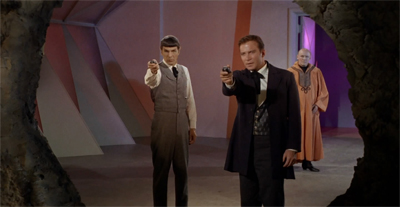

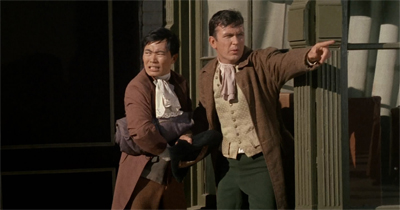






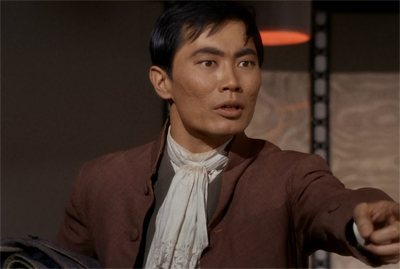
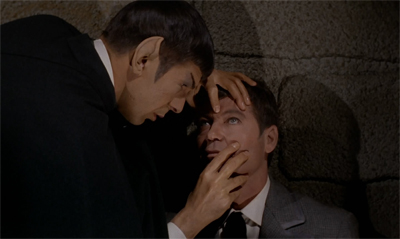

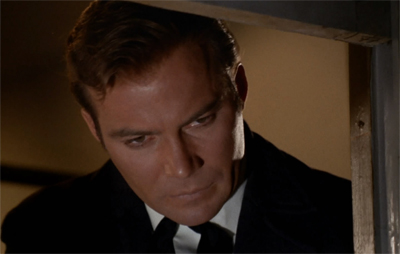
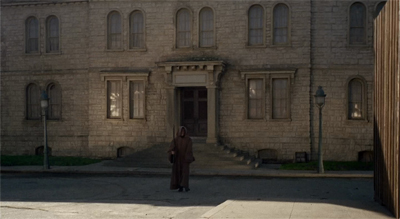
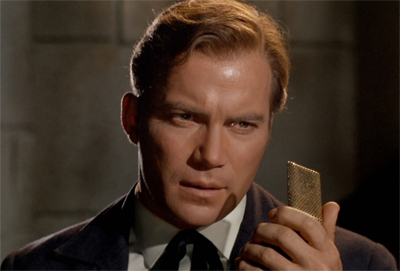
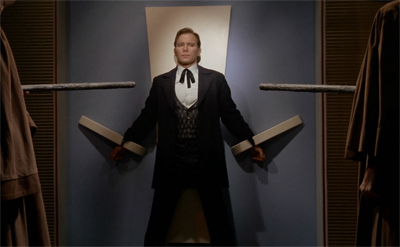
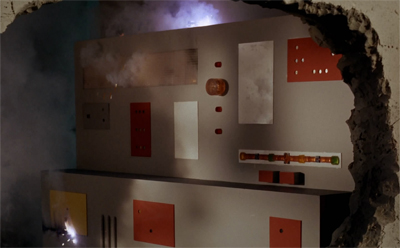

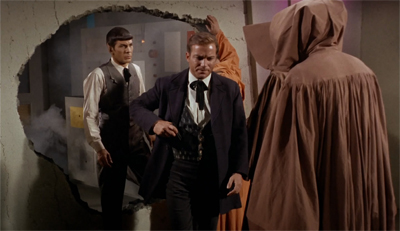
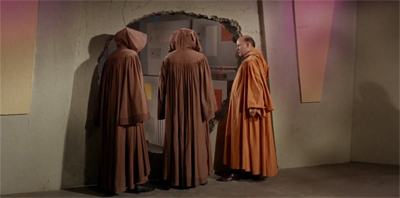






Darren, you beat me to it.
I was going to do a complete analysis of “Return of the Archons” as ‘Gene Roddenberry’s brilliant take-down of religion’ but you have done all that awesome work already. Great job!
As the Christian right-wing in America grows ever more strident, and Islamic groups assert themselves across the world it seems more urgent than ever for people to admit they “Are NOT of the body”.
The character ‘Landru’ is clearly God, Allah, Jesus, Zeus – and every other god ever invented by man.
Thanks Max.
While I agree, I also think that – paradoxically – Landrau is also Communism and Socialism. One of the strengths of something as allegorical as Star Trek is that it’s possible to have a metaphor that plays across multiple levels. This makes it fun to try to analyse, because it’s interesting to try and figure out what was intended, what was coincidental – and how it fits in the author’s body of work. (Roddenberry was both an atheist and – at this point in his career, it seems – ardently anti-Communist, so both readings fit.)
Darren,
You are certainly correct about the anti-Communism angle, too. I’m with you 100% on that. Roddenberry’s dislike of religion certainly showed up in many episodes – ‘All our Yesterdays’ comes to mind where Kirk is inadvertently hunted down as a “witch”.
Communism did ultimately manifest as an Agrarian cult with religious supernatural claims; Stalin’s agrarian ‘miracles’ of Lysenko would be one example of religion’s influence on Stalin. Though Stalin was an Atheist (As Landrau may have been) it is the demand for conformity and the claims of “higher power” which so upset Roddenberry. Stalin would never have succeeded if there weren’t a population so ready for a holy “Czarist” cause.
I really love your whole analysis and I’m so glad you called attention to it.
Roddenberry was so ahead of his time.
Reblogged this on Atheist Max – God to Godless and commented:
For Atheists who happen to be Star Trek fans there are several familiar episodes of the Original Series where Gene Roddenberry’s Atheism and distrust of religion comes through in brilliant allegory.
One which I never get tired of is “Return of the Archons” where an entire civilization is run by a computer program named “Landru”.
A blogger named “Darren” has done a masterful analysis of the episode and its obvious parallels with religion.
If you are familiar with Star Trek, but new to Atheism, please go straight to this episode and have your mind blown.
Are you ‘of the body?’ or Not!
And the question was right there in front of you all this time.
Thanks for the kind words! I’ll be starting the second season in December.
I wonder if the writers of The Purge ever saw this episode.